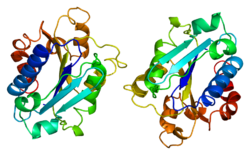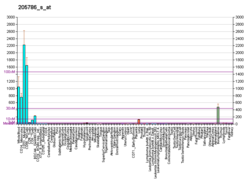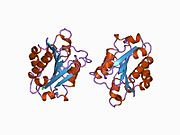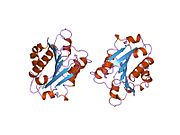Integrin alpha M
Integrin alpha M(ITGAM) is one protein subunit that formsheterodimericintegrinalpha-M beta-2 (αMβ2) molecule, also known asmacrophage-1 antigen(Mac-1) orcomplement receptor3(CR3).[5]ITGAM is also known as CR3A, andcluster of differentiationmolecule 11B (CD11B). The second chain of αMβ2is the common integrin β2subunit known asCD18,and integrin αMβ2thus belongs to the β2subfamily (or leukocyte) integrins.[6]
αMβ2is expressed on the surface of manyleukocytesinvolved in theinnate immune system,includingmonocytes,granulocytes,macrophages,andnatural killer cells[5]and subsets of T and B cells.[7]It mediates inflammation by regulating leukocyteadhesionand migration and has been implicated in several immune processes such asphagocytosis,cell-mediated cytotoxicity,chemotaxisand cellular activation.[5]It is involved in thecomplement systemdue to its capacity to bind inactivatedcomplement component 3b(iC3b).[8]The ITGAM (alpha) subunit of integrin αMβ2is directly involved in causing the adhesion and spreading of cells but cannot mediate cellular migration without the presence of the β2 (CD18) subunit.[5]
In genomewide association studies, single nucleotide polymorphisms in ITGAM had the strongest association withsystemic lupus erythematosus,with an odds ratio of 1.65 for the T allele of rs9888739 and lupus.[9][10]
Inhistopathology,immunohistochemistry with antibodies against CD11B is frequently used to identifymacrophagesandmicroglia.
Function of CD11b
[edit]CD11b, as anintegrinmolecule on the surface ofleukocytes,plays an important role in cell migration, adhesion, andtransmigrationacrossblood vessels,because it can bind to components ofextracellular matrixand intracellular adhesion molecules (ICAMs) on theendothelial surface.This process is important for leukocyte recruitment into the site ofinflammation.[7]
Moreover, there are other important processes with CD11b involvement, more precisely Mac-1 integrin involvement as a whole. One of which isphagocytosisof opsonised particles by acomplementcomponent iC3b. Such opsonised particles could bebacteria,apoptotic cells,and evenimmune complexes.CD11b binding to iC3b leads to a production of anti-inflammatorycytokines,e.g.,interleukin 10 (IL-10)andtumour growth factor beta (TGFβ).This process is important for regulation of the inflammatory milieu.[7][11]
CD11b is also involved in the differentiation ofosteoclasts,bone remodelling cells. Mac-1 is expressed in osteoclast progenitors, and it seems that it is a part of a negative feedback of osteoclastogenesis.[11]CD11b also modulates other functions of leukocytes, e.g.oxidative burst,apoptosis,binding offibrinogenetc.[12]
On circulatingleukocytes,CD11b is expressed in a closed conformation. The switch into an active conformation follows quickly after the stimulation oftoll-like receptors (TLR)of theleukocytes.[7]Once activated, CD11b can bind its ligands with high affinity, e.g., binding ofICAM-1orICAM-2molecules onendotheliumand subsequent adhesion. CD11b signalling is also known to interfere withTLRsignalling in the cell.TLRstimulation results in the production ofpro-inflammatory cytokines,e.g.,IL-6andIL-1β,via a series ofphosphorylationof signalling factors, one of which is theNF-κB transcription factor.[13]This signalling is in fact negatively affected by CD11b signalling. Consequently, this leads to a reduced activation ofNF-κBand lower production of above-mentionedpro-inflammatory cytokines.To conclude, CD11b signalling negatively regulatesleukocyteactivation afterTLRstimulation.[7][12]BesideTLR signalling,CD11b also negatively regulatesB cell receptor (BCR)signalling, and it suppressesT cell activationanddendritic cellmaturation and function.[7]
Therapeutic significance of CD11b
[edit]Regarding CD11b function, it is apparent that it plays an important role in immune cell regulation. Once this regulation is disrupted, it may lead to a higher susceptibility to inflammatory andautoimmune diseases.Some examples would besystemic lupus erythematosus (SLE),lupus nephritisand certain types ofcancer.[12][14]
Systemic Lupus Erythematosus
[edit]Genome Wide Association Studieshelped to uncover 3 mainsingle nucleotide polymorphisms (SNPs)in CD11b, that are associated with the risk of developingSLE,cardiovascular disease,andlupus nephritis(a complication usually occurring along withSLE). TheseSNPsare: rs1143679 (R77H), rs1143678 (P1146S), and rs1143683 (A858V) and they result in the lower ability of CD11b to properly bindICAM-1andiC3b,thus decreased cell adhesion andphagocytosis.Reduced ability to negatively regulate the production ofpro-inflammatory cytokinesIL-6,IL-1β,andtumour necrosis factor α (TNFα)afterTLRstimulation have been also observed in thesemutations.[12]
CD11b plays a protective role duringSLEandlupus nephritisowing to itsanti-inflammatoryproperties.Lupus nephritisis characterised by the accumulation ofimmune complexesin kidneys and overall immune infiltration into kidneys, which results in renal damage. This debilitating complication ofSLEis associated with the above-mentioned mutations in CD11b. Patients withITGAMSNPshave higher serum levels ofinterferon type I (IFN-I),which is one of the risk factors for developingSLEandlupus nephritis.Moreover, higher levels of otherpro-inflammatory cytokinesIL-6,IL-1βandTNFαafterTLRstimulation, observed in patients withITGAMSNPs,further drive theinflammationduring this disease causing more tissue damage and creation ofimmune complexes.[7][12]
Hence, CD11b represents a possible therapeutic target for the treatment ofSLE.Indeed, many attempts to target CD11b have been made. Firstly,antibody-based therapy which proved to be ineffective in the case of CD11b.[15]However, other therapies using small allosteric CD11bagonistsseem to be a promising tool as their activation of CD11b leads to a regulation ofTLR-dependant pro-inflammatory pathways and protection from renal damage.[12]
Tumours
[edit]CD11b seems to be a potent player in managing certain types ofsolid tumours.Even though nowadays many tools forcancertreatment exist, multiple factors of this illness remain a challenging topic. One of them aremyeloid-derived suppressor cells(MDSC) andtumour-associated macrophages (TAMs),which aremyeloid cellspresent in thetumour microenvironmentpossessing suppressor properties, thus favouring thetumourgrowth.TAMs,however, do not have only tumour-promoting properties, they can also display tumour-inhibiting properties. It depends on their stimulation. The tumour-inhibiting properties include the production ofpro-inflammatory cytokinesand the ability topresent antigens.[14]
Using CD11b agonists seems to be of importance intumourtreatment. Agonist that stabilize CD11b in its active conformation result in higher adhesion of CD11b to its endothelial ligands, consequently impair the ability oftransendothelial migrationto the site ofinflammation.Suchagonisttherapy is under development and one promising candidate, GB1275, is currently in its first clinical phase at the beginning of 2023. This agonist of CD11b shows impairedtransmigrationof suppressiveTAMsinto the site oftumourand modulation ofTAMstowards pro-inflammatory phenotype with higherantigen presentationand production ofpro-inflammatory cytokines.Therefore, promising better tumour inhibition.[14]
See also
[edit]References
[edit]- ^abcGRCh38: Ensembl release 89: ENSG00000169896–Ensembl,May 2017
- ^abcGRCm38: Ensembl release 89: ENSMUSG00000030786–Ensembl,May 2017
- ^"Human PubMed Reference:".National Center for Biotechnology Information, U.S. National Library of Medicine.
- ^"Mouse PubMed Reference:".National Center for Biotechnology Information, U.S. National Library of Medicine.
- ^abcdSolovjov DA, Pluskota E, Plow EF (January 2005)."Distinct roles for the alpha and beta subunits in the functions of integrin alphaMbeta2".The Journal of Biological Chemistry.280(2): 1336–1345.doi:10.1074/jbc.M406968200.PMID15485828.
- ^Larson RS, Springer TA (April 1990). "Structure and function of leukocyte integrins".Immunological Reviews.114:181–217.doi:10.1111/j.1600-065X.1990.tb00565.x.PMID2196220.S2CID36709941.
- ^abcdefgKhan SQ, Khan I, Gupta V (2018-03-15)."CD11b Activity Modulates Pathogenesis of Lupus Nephritis".Frontiers in Medicine.5:52.doi:10.3389/fmed.2018.00052.PMC5862812.PMID29600248.
- ^Arnaout MA, Todd RF, Dana N, Melamed J, Schlossman SF, Colten HR (July 1983)."Inhibition of phagocytosis of complement C3- or immunoglobulin G-coated particles and of C3bi binding by monoclonal antibodies to a monocyte-granulocyte membrane glycoprotein (Mol)".The Journal of Clinical Investigation.72(1): 171–179.doi:10.1172/JCI110955.PMC1129172.PMID6874946.
- ^Crow MK (February 2008). "Collaboration, genetic associations, and lupus erythematosus".The New England Journal of Medicine.358(9): 956–961.doi:10.1056/NEJMe0800096.PMID18204099.
- ^Hom G, Graham RR, Modrek B, Taylor KE, Ortmann W, Garnier S, et al. (February 2008)."Association of systemic lupus erythematosus with C8orf13-BLK and ITGAM-ITGAX".The New England Journal of Medicine.358(9): 900–909.doi:10.1056/NEJMoa0707865.PMID18204098.
- ^abBednarczyk M, Stege H, Grabbe S, Bros M (February 2020)."β2 Integrins-Multi-Functional Leukocyte Receptors in Health and Disease".International Journal of Molecular Sciences.21(4): 1402.doi:10.3390/ijms21041402.PMC7073085.PMID32092981.
- ^abcdefVillanueva V, Li X, Jimenez V, Faridi HM, Gupta V (July 2022)."CD11b agonists offer a novel approach for treating lupus nephritis".Translational Research.245:41–54.doi:10.1016/j.trsl.2022.03.001.PMC9167730.PMID35288363.
- ^Fitzgerald KA, Kagan JC (March 2020)."Toll-like Receptors and the Control of Immunity".Cell.180(6): 1044–1066.doi:10.1016/j.cell.2020.02.041.PMC9358771.PMID32164908.
- ^abcDeNardo DG, Galkin A, Dupont J, Zhou L, Bendell J (August 2021)."GB1275, a first-in-class CD11b modulator: rationale for immunotherapeutic combinations in solid tumors".Journal for Immunotherapy of Cancer.9(8): e003005.doi:10.1136/jitc-2021-003005.PMC8404448.PMID34452928.
- ^Kabanov DS, Grachev SV, Prokhorenko IR (2020-11-21)."Monoclonal Antibody to CD14, TLR4, or CD11b: Impact of Epitope and Isotype Specificity on ROS Generation by Human Granulocytes and Monocytes".Oxidative Medicine and Cellular Longevity.2020:5708692.doi:10.1155/2020/5708692.PMC7700042.PMID33294123.
Further reading
[edit]- Stewart M, Thiel M, Hogg N (October 1995). "Leukocyte integrins".Current Opinion in Cell Biology.7(5): 690–696.doi:10.1016/0955-0674(95)80111-1.PMID8573344.
- Todd RF, Petty HR (May 1997). "Beta 2 (CD11/CD18) integrins can serve as signaling partners for other leukocyte receptors".The Journal of Laboratory and Clinical Medicine.129(5): 492–498.doi:10.1016/S0022-2143(97)90003-2.PMID9142045.
- Schymeinsky J, Mócsai A, Walzog B (August 2007). "Neutrophil activation via beta2 integrins (CD11/CD18): molecular mechanisms and clinical implications".Thrombosis and Haemostasis.98(2): 262–273.doi:10.1160/th07-02-0156.PMID17721605.S2CID41094726.
External links
[edit]- Integrin+alphaMat the U.S. National Library of MedicineMedical Subject Headings(MeSH)
- Mouse CD Antigen Chart
- Human CD Antigen Chart
- ITGAMInfo with links in theCell Migration GatewayArchived2014-12-11 at theWayback Machine















